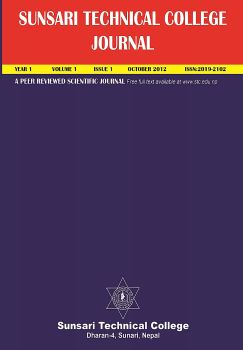Antimicrobial resistance pattern of Esherichia coli isolated from urine samples in patients visiting tertiary health care centre in Eastern Nepal
DOI:
https://doi.org/10.3126/stcj.v1i1.8657Keywords:
UTI, E. coli, Antimicrobial resistance, MDRAbstract
Background: Urinary tract infection (UTI) is one of the commonest bacterial infections caused by microbial invasion of tissue lining the urinary tract. Escherichia coli is the primary etiologic agent among both outpatients and inpatients. Antimicrobial resistance is an evolving and growing problem in UTI. Of more concern is increasing incidence of infections caused by strains of E. coli that are resistant to commonly used antimicrobial agents.
Objective: The study was conducted with the objective to monitor the prevalence of E. coli and to assess the trend of drug resistance in patients visiting Nobel Medical College, Biratnagar, Nepal.
Materials and Methods: Specimens were collected aseptically and cultured in bacteriological culture media and identified by using standard microbiological techniques as described in Bergey’s Manual of systemic bacteriology. Antimicrobial susceptibility test was performed by modified Kirby-Bauer disk diffusion method.
Results: Of 508 non-repeated urine samples the total growth was 18.30% (n=93). E. coli accounted for 86.02% (n=80). Highest samples were belonged to the age group 21-40 years and least samples belonged to the age group >61.Of total antibiotics used, amikacin showed the highest susceptibility of 96.25% followed by nitrofurantoin, gentamicin, cefotaxime and ceftazidime with 92.5%, 77.5%, 72.5% and 71.25% respectively among the isolates. Least susceptibility was shown by nalidixic acid with 22.5%. About half of the isolates were susceptible to norfloxacin and ciprofloxacin while no significant differences were seen among susceptibility to different antibiotics and age groups. Total multiple drug resistance (MDR) was 38.75% (n=31) with highest isolates belonged to the age group 21-40 years and least belonged to the age group <20 years. However, no significant difference was seen between MDR and age groups. The MDR was higher in male, 59.1% (13/22) than in female, 31.03% (18/58) which was statistically significant (p=0.021) showing about three times more MDR in male than in female.
Conclusion: This study found more than one third of the urinary E. coli isolates were MDR. Higher resistance was seen to fluroquinolones and about one third to third generation cephalosporins. This necessitates a reevaluation of first and second line therapies for the treatment of UTI and regular monitoring of the usage of antimicrobials is done so as to optimize the empirical therapy.
DOI: http://dx.doi.org/10.3126/stcj.v1i1.8657
Sunsari Technical College Journal Vol.1(1) 2012 22-26




